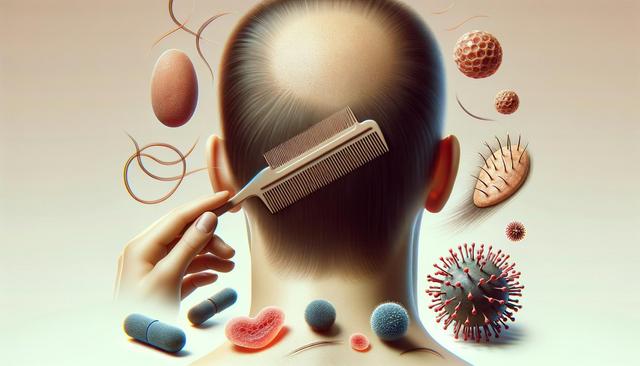Understanding the Root Causes of Baldness
Before exploring methods to encourage hair growth, it’s important to understand why baldness occurs. Hair loss can be caused by a combination of factors, including genetics, hormonal changes, aging, nutritional deficiencies, and certain medical conditions. Male and female pattern baldness, for example, is largely hereditary, while other types may stem from autoimmune diseases or stress-related conditions. Identifying the underlying reason for hair thinning or balding is a crucial first step in choosing the right care or treatment method.
Common causes of hair loss include:
- Genetics (androgenic alopecia)
- Hormonal imbalances (e.g., thyroid disorders)
- Poor nutrition or sudden weight loss
- Stress and anxiety
- Scalp infections or skin conditions
Understanding these causes allows for more targeted approaches, whether nutritional changes, medical treatments, or topical applications. While some causes may require professional diagnosis, many people can start with lifestyle adjustments and gentle scalp care techniques.
Exploring Scalp Microneedling as a Potential Method
One method that has gained interest for helping stimulate hair growth is scalp microneedling. This process involves using fine needles to create tiny punctures in the scalp, which may promote blood flow and trigger the body’s natural healing response. Though originally used for facial skin rejuvenation, microneedling is now being explored as a technique to reactivate hair follicles in areas affected by thinning or baldness.
Potential benefits of scalp microneedling include:
- Improved circulation to the hair follicles
- Enhanced absorption of topical treatments
- Stimulation of collagen and keratin production
Microneedling is often used in combination with topical serums or oils, which may help deliver nutrients directly to the hair roots. While more research is needed to confirm its effectiveness for all individuals, early studies and anecdotal evidence suggest that it may support hair regrowth in some cases.
Natural Oils and Gentle Hair Care
In addition to advanced methods like microneedling, natural oils and gentle scalp care continue to be recognized for their potential to support healthier hair. Oils such as rosemary, peppermint, and castor oil are often used in traditional hair care routines due to their soothing and nourishing properties. These oils can be massaged into the scalp to help improve circulation and reduce dryness or irritation.
Tips for using oils effectively include:
- Warm the oil slightly before application
- Massage gently into the scalp for 5–10 minutes
- Leave on for at least 30 minutes or overnight before washing
- Use a mild, sulfate-free shampoo to rinse
Gentle care practices—avoiding excessive brushing, limiting heat styling, and using protective hairstyles—can also reduce breakage and preserve existing hair. Over time, consistent care may help maintain a healthier scalp environment, which is essential for potential regrowth.
The Role of Nutrition in Hair Health
Nutrition plays a key role in maintaining strong, healthy hair. Deficiencies in specific nutrients can contribute to hair thinning and loss, particularly if the scalp is not getting enough of the building blocks it needs for hair production. Iron, zinc, vitamin D, biotin, and protein are among the most critical nutrients for supporting hair growth.
Key nutrients to include in a hair-supportive diet:
- Iron: Found in leafy greens, beans, and lean meats
- Biotin: Present in eggs, nuts, and whole grains
- Vitamin D: Sourced from sunlight and fortified foods
- Protein: Essential in meat, dairy, tofu, and legumes
- Zinc: Found in seeds, seafood, and whole grains
Those experiencing hair loss may benefit from a nutritional assessment to determine if supplementation is needed. In some cases, improving dietary habits alone can have a noticeable effect on hair thickness and overall scalp health.
Stress Management and Lifestyle Adjustments
Chronic stress is frequently linked to hair shedding and thinning due to its impact on hormonal balance and immune function. Managing stress effectively can therefore be a meaningful part of a broader strategy to encourage hair growth. Techniques such as meditation, regular exercise, and sleep hygiene can aid in maintaining hormonal stability and reducing inflammation, which may support healthier hair.
Effective stress-relief methods include:
- Deep breathing exercises and mindfulness meditation
- Physical activity such as walking, cycling, or yoga
- Quality sleep—aiming for 7–9 hours per night
- Limiting caffeine and alcohol intake
- Spending time in nature or engaging in hobbies
While lifestyle changes may not reverse advanced baldness, they can create a more favorable environment for hair to grow and stay healthy. Combining stress reduction with scalp care and nutritional support may offer a holistic approach to managing hair loss.
Conclusion: A Thoughtful Approach to Hair Regrowth
For those seeking ways to encourage hair growth in areas of baldness, understanding the root causes and exploring a variety of care methods can make a significant difference. Natural oils, a nutrient-rich diet, stress management, and techniques like scalp microneedling offer possible paths worth considering. While results may vary depending on the individual and the cause of hair loss, these approaches contribute to a healthier scalp environment and may support the conditions needed for hair to grow again. Consistency and patience are key—sustainable changes often bring the most noticeable results over time.


